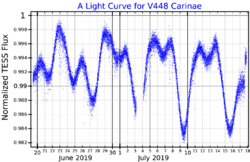Astronomy:V448 Carinae
| Observation data Equinox J2000.0]] (ICRS) | |
|---|---|
| Constellation | Carina |
| Right ascension | 06h 47m 18.70799s[2] |
| Declination | −55° 32′ 23.9659″[2] |
| Apparent magnitude (V) | 5.60[3] (5.66 to 5.86)[4] |
| Characteristics | |
| Spectral type | K5III[5] |
| B−V color index | +1.549±0.010[3] |
| Variable type | SRd:[4] |
| Astrometry | |
| Radial velocity (Rv) | +25.58±4.64[2] km/s |
| Proper motion (μ) | RA: −0.99[6] mas/yr Dec.: +25.05[6] mas/yr |
| Parallax (π) | 4.8123 ± 0.0860[2] mas |
| Distance | 680 ± 10 ly (208 ± 4 pc) |
| Absolute magnitude (MV) | −0.72[3] |
| Details | |
| Mass | 1.73[7] M☉ |
| Radius | 50.90+1.15 −5.11[2] R☉ |
| Luminosity | 582.2±12.9[2] L☉ |
| Temperature | 3,974+216 −44[2] K |
| Age | 2.85[7] Gyr |
| Other designations | |
| Database references | |
| SIMBAD | data |
V448 Carinae is a single[9] star in the constellation Carina. It has the Bayer designation O Carinae, while V448 Carinae is the variable star designation. This object has an orange hue and is dimly visible to the naked eye with an apparent visual magnitude that fluctuates around 5.60.[3] It is located at a distance of approximately 680 light years from the Sun based on parallax, and is drifting further away with a radial velocity of around +26 km/s.[2]
This is an aging giant star with a stellar classification of K5III.[5] Having exhausted the supply of hydrogen at its core, it has cooled and expanded off the main sequence and now has 51 times the girth of the Sun.[2] It is classified as a probable semiregular variable star with a sub-type of SRd and a brightness that varies from visual magnitude 5.66 down to 5.86 over a period of 56.5 days.[4] The star is an estimated 2.85 billion years old with 1.73 times the mass of the Sun.[7] It is radiating 582 times the luminosity of the Sun from its swollen photosphere at an effective temperature of 3,974 K.[2]
References
- ↑ "MAST: Barbara A. Mikulski Archive for Space Telescopes". Space Telescope Science Institute. https://mast.stsci.edu/portal/Mashup/Clients/Mast/Portal.html.
- ↑ 2.0 2.1 2.2 2.3 2.4 2.5 2.6 2.7 2.8 2.9 Brown, A. G. A. (August 2018). "Gaia Data Release 2: Summary of the contents and survey properties". Astronomy & Astrophysics 616: A1. doi:10.1051/0004-6361/201833051. Bibcode: 2018A&A...616A...1G. Gaia DR2 record for this source at VizieR.
- ↑ 3.0 3.1 3.2 3.3 Anderson, E.; Francis, Ch. (2012), "XHIP: An extended hipparcos compilation", Astronomy Letters 38 (5): 331, doi:10.1134/S1063773712050015, Bibcode: 2012AstL...38..331A.
- ↑ 4.0 4.1 4.2 Samus, N. N. et al. (2017), "General Catalogue of Variable Stars", Astronomy Reports, 5.1 61 (1): 80–88, doi:10.1134/S1063772917010085, Bibcode: 2017ARep...61...80S.
- ↑ 5.0 5.1 Houk, Nancy; Cowley, A. P. (1979), Michigan catalogue of two-dimensional spectral types for the HD stars, 1, Ann Arbor, Michigan: Dept. of Astronomy, University of Michigan, Bibcode: 1978mcts.book.....H.
- ↑ 6.0 6.1 van Leeuwen, F. (2007), "Validation of the new Hipparcos reduction", Astronomy and Astrophysics 474 (2): 653–664, doi:10.1051/0004-6361:20078357, Bibcode: 2007A&A...474..653V.
- ↑ 7.0 7.1 7.2 Luck, R. Earle (2015), "Abundances in the Local Region. I. G and K Giants", The Astronomical Journal 150 (3): 88, doi:10.1088/0004-6256/150/3/88, Bibcode: 2015AJ....150...88L.
- ↑ "V448 Car". SIMBAD. Centre de données astronomiques de Strasbourg. http://simbad.u-strasbg.fr/simbad/sim-basic?Ident=V448+Car.
- ↑ Eggleton, P. P.; Tokovinin, A. A. (September 2008), "A catalogue of multiplicity among bright stellar systems", Monthly Notices of the Royal Astronomical Society 389 (2): 869–879, doi:10.1111/j.1365-2966.2008.13596.x, Bibcode: 2008MNRAS.389..869E.
 |


